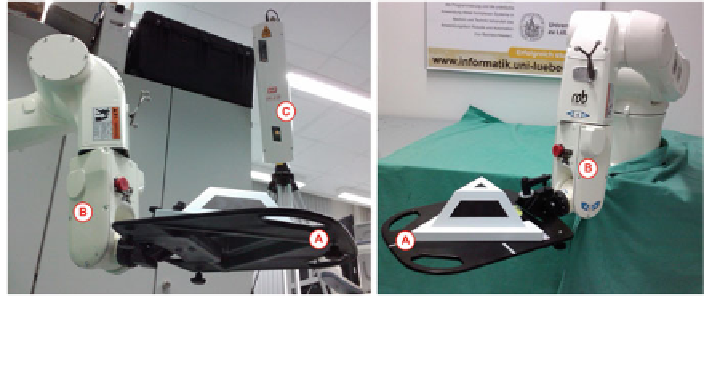Biomedical Engineering Reference
In-Depth Information
Therefore, the real head must be measured by the laser scanner and the obtained
head must be registered to the virtual head, obtained e.g. by an MRI-scan.
8.3.1 Implementation of Direct Head Tracking with Laser
Scans
We use a GALAXY laser system (LAP GmbH Laser Applikationen, Lüneburg,
Germany) for head navigation. The GALAXY laser scanner has a scan volume of
670
950
490 m
3
up to 800
1300
600 m
3
. The scanning time depends on
the resolution and on the size of the scanning volume. The time needed to perform
one scan is in the range of 1-5 s. With a reduced resolution and in real-time mode,
the laser system can reach a scanning frequency of up to 5 Hz. The scanner has a
repeatability of less than 0.1 mm and an accuracy in the acquired patient position
of less than 0.1 mm. The resolution in the measurement axis of the laser scanner is
specified with 0.2 mm for the y- and z-axis, and with 0.5 mm for the x-axis [
13
].
A high resolution scan of a human head consists therefore of approximately 10,000
surface points.
8.3.1.1 Calibration of 3D Laser Scanner to Robot
As previously discussed in
Chap. 4
, a calibration of tracking system to robot must
be performed to transform the provided tracking data into the robot coordinate
frame. This is also required for a 3D laser scanner. We use a specific calibration
phantom provided with the GALAXY system that we attach to the robot's end
effector as visualized in Fig.
8.1
.
(a)
(b)
Fig. 8.1 The setup for calibrating the laser scanner to the robot. a The laser scanner (C) in the
back scans a calibration tool (A) that is mounted to the robot's end effector (B). b The calibration
tool in a zoomed view

Search WWH ::

Custom Search